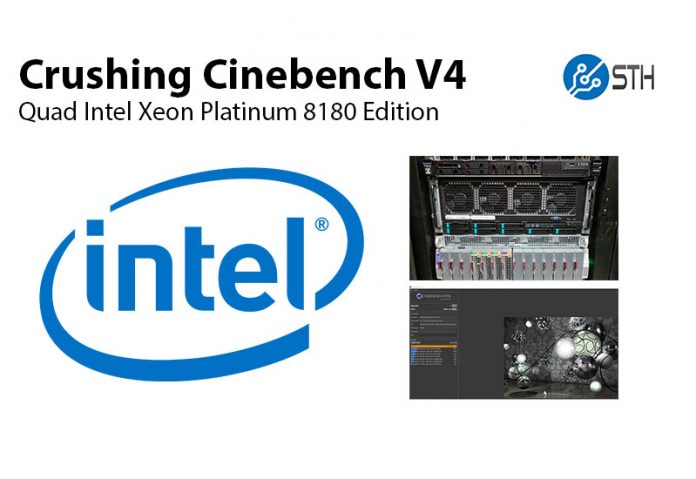Running Cinebench is not something that I enjoy as it means we have to boot into Windows. At the same time, it is something that we have done for other four socket machines and the AMD EPYC 7601 top end parts. At an Intel briefing earlier this year, Johan at AnandTech told me I should run Cinebench R15 on the quad Intel Xeon 8180 machine. We also had a number of readers request this after we published our quad Intel Xeon Platinum 8180 benchmarks. Between our reader requests and Johan’s, it was time to oblige. We had a few minutes before running a 144-hour workload so it was time to give the quad Intel Xeon Platinum 8180 system its turn to crush Cinebench. What we found was a machine so fast that it is starting to break the default Cinebench R15 render scene because that scene is not complex enough.
Crushing Cinebench R15 V4: Quad Intel Xeon 8180 Edition
While I will maintain that I am not a huge fan of using Cinebench as a benchmark, especially in a world where it is not optimized for features like AVX-512 and runs extraordinarily well on AMD Zen architectures, we did it again. Introducing a 9300+ result.
Update: We did an update using release drivers and we now have what may be the first 11,000+ Cinebench result. The benchmark is really struggling to scale with a system this good as the variances are now 15% per run. Still, it is an impressive result. We do hope Maxon releases a significantly (10x or more) harder and longer running render scene.
If you want to check out some of the previous series:
- Crushing Cinebench V1: Quad Intel Xeon E7-8870 V3
- Crushing Cinebench V2: Quad Intel Xeon E7-8890 V4
- Crushing Cinebench V3: Dual AMD EPYC 7601
An honorable mention is the Intel Xeon Phi x200 series (7210) that we ran Cinebench on just to show x86 compatibility with Windows here. That one had more threads (256) but each core is nowhere near the power of the Skylake-SP core.
Perhaps the most relevant video we can show is comparing the previous generation Intel Xeon E7-8890 V4 video to what we have today. Even though this benchmark will run extremely well on EPYC, having four sockets helps. Here is the V2 video:
Without further adieu, here is Crushing Cinebench R15 V4: Quad Intel Platinum 8180 Edition:
As you can see, having 224 threads is becoming troublesome. There is a huge variation in terms of each run which often happens when we see a scheduler struggle with a higher number of threads as an example. Although we will not publish a video on smaller dual socket systems, the dual Xeon Platinum 8180 system is significantly more consistent which is why we think it is a Windows Server 2016 struggle.
Still, with a score of over 9300, we feel that this is a solid follow-up to the V2 version.
Final Words
On a more serious note, the new Intel Xeon Scalable Processor Family has some awesome new technology. We have already shown that even without accessing big ticket features like AVX-512, the new family can crush last generation’s 4-socket leaders. In our initial quad Intel Xeon Platinum 8180 benchmarks and new Platinum 8176 initial benchmarks, we show these systems capable of easily outpacing the previous generation quad Intel Xeon E7-8890 V4 setups as well as older generations (ready for replacement cycles) such as octo Xeon E7-8870 V2 machines.
We have the most complete set of technical background information, benchmarks (not Cinebench!), and vendor announcements for the new chips at our Intel Xeon Scalable Processor Family (Skylake-SP) Launch Coverage Central.
Feel free to stop in and discuss this on the STH forums.





I don’t think developers are going to start using AVX-512 until it gets to mainstream. So far only, Skylake SP/X support it. The next generation Coffee Lake will not support AVX-512 either.
Finally Cinenbench! :-P
Ed: AVX-512 is already being used extensively in HPC and the new Xeon parts are now bringing the same software into Even consumer-grade software like X264 is integrating AVX-512 and it will only spread as more and more platforms add support.
Can you try to test speeds Windows Server 2012 R2 vs 2016 ?
Some people are saying 2012 R2 is performing faster than 2016 in server grade enviroments.
It should be interesting to see which one wins.
@Don, that’s in-house custom code. I was talking about “off the shelf” software (for instance Cinebench)
So 4 x $ 10.000 =$ 40.000 cpu’s are ((9400/5400)-1)x100 ~ 75% faster than 2 x $ 4.200 = $ 8.400 cpu’s.
Not bad intel.
My car is also faster then my moped.
It’s over 9000!
[img]http://i1.kym-cdn.com/entries/icons/original/000/000/056/itsover1000.jpg[/img]
@Misha
It’s not scaling to all the cores. Dual socket 8180 was tested to get >8k, so a quad socket getting 9k means its less than 20% faster
Exactly, this seems to actually be breaking Cinebench
Uhhm just invested in 3 now generations old e5-2696 v3, two of which should be able to manage 4200’ish in Cinebench (for rendering), so underwhelmed….
Lol my 3950x hit 10,000 with a very modest overclock just 3 yrs later with only 32 threads. Tech is scaling exponentially, just watch as it becomes indistinguishable from magic.